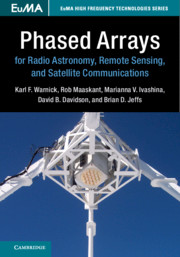Book contents
- Frontmatter
- Contents
- Preface
- Acknowledgements
- Notation and Units
- 1 Phased Arrays for High-sensitivity Receiver Applications
- 2 Active Antenna Receivers
- 3 Antenna Examples
- 4 Transmitting Arrays, Network Analysis, and Pattern Overlap Integrals
- 5 Array Receiver Theory and Modeling
- 6 Figures of Merit for Active Receiving Arrays
- 7 Design and Optimization of Phased Array Antennas
- 8 Numerical Modeling of Phased Array Antennas
- 9 Analog Front End, Array Elements, and Receiver Electronics
- 10 Array Signal Processing, Calibration, and Beamforming
- 11 Interferometric Arrays and Synthesis Imaging
- 12 Real Time Digital Signal Processing
- Index
Preface
Published online by Cambridge University Press: 14 July 2018
- Frontmatter
- Contents
- Preface
- Acknowledgements
- Notation and Units
- 1 Phased Arrays for High-sensitivity Receiver Applications
- 2 Active Antenna Receivers
- 3 Antenna Examples
- 4 Transmitting Arrays, Network Analysis, and Pattern Overlap Integrals
- 5 Array Receiver Theory and Modeling
- 6 Figures of Merit for Active Receiving Arrays
- 7 Design and Optimization of Phased Array Antennas
- 8 Numerical Modeling of Phased Array Antennas
- 9 Analog Front End, Array Elements, and Receiver Electronics
- 10 Array Signal Processing, Calibration, and Beamforming
- 11 Interferometric Arrays and Synthesis Imaging
- 12 Real Time Digital Signal Processing
- Index
Summary
Many excellent books on phased array antennas are already in print. The theoretical and mathematical content commonly found in books on this topic has stabilized in the last decade or two, but the past ten years has seen a dramatic departure from classical analytical tools in the methodologies used to design and optimize phased arrays. Our goal is to gather in one place recent advances in the mathematical framework for phased array analysis and create a book for which the theoretical treatment reflects the state-ofthe- art in the academic literature and is equal to the task of designing antenna arrays for applications with demanding performance requirements.
One of the themes of this book is the design of phased arrays based on computer simulation. The last few decades have seen enormous progress in computational electromagnetics (CEM), which has revolutionized our ability to analyze antennas rigorously. The framework developed in this book can be used either with analytical approximations for the antenna response, or with computational electromagnetics tools for more accurate results.
Another theme is the dedicated analysis of active receiving arrays using network theory and the signal correlation matrix formulation. Most antenna textbooks focus almost exclusively on the antenna as a transmitting system, and then mention that the reciprocity theorem extends this analysis to receiving systems. Modern phased array systems involve active front ends, with low noise amplifiers in close proximity to the antenna or even integrated into the antenna feed. The system in this case is nonreciprocal, and some conventional antenna concepts no longer apply. Many systems use digital beamforming, which provides additional degrees of freedom when compared to classical analog beamformers. These systems require a new vocabulary and new figures of merit to properly describe them; where possible, we reconcile these with traditional antenna terms.
The authors have been closely involved in modern developments in phased arrays, computational electromagnetics, and array signal processing for applications in challenging fields such as radio astronomy for many years. This text represents the first synthesis of these modern design methods as a book; this is complemented by a review of classical methods such as the array factor approximation.
- Type
- Chapter
- Information
- Publisher: Cambridge University PressPrint publication year: 2018

